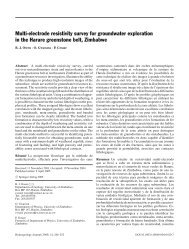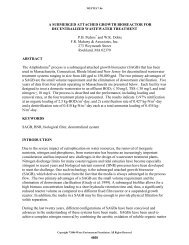Species diversity in the Florida Everglades, USA - Environmental ...
Species diversity in the Florida Everglades, USA - Environmental ...
Species diversity in the Florida Everglades, USA - Environmental ...
Create successful ePaper yourself
Turn your PDF publications into a flip-book with our unique Google optimized e-Paper software.
264 M. T. Brown et al. Ecosystem bio<strong>diversity</strong> <strong>in</strong> <strong>the</strong> <strong>Florida</strong> <strong>Everglades</strong><br />
cana) and <strong>the</strong> red-cockaded woodpecker (Picoides borealis)<br />
(Table 7).<br />
Mammals. Mammalian distributions, evolution, and ecology<br />
(like those of <strong>the</strong> o<strong>the</strong>r vertebrates) are <strong>in</strong>fl uenced by<br />
<strong>the</strong> geographic, geological, and environmental characteristics<br />
of South <strong>Florida</strong> (Robertson and Federick, 1994).<br />
Geographic factors affect<strong>in</strong>g mammalian distributions and<br />
abundances <strong>in</strong>clude: 1) <strong>the</strong> relative isolation of south<br />
<strong>Florida</strong> from <strong>the</strong> ma<strong>in</strong> North American land mass because<br />
of its location at <strong>the</strong> end of a long pen<strong>in</strong>sula, 2) <strong>the</strong> fact<br />
that it is <strong>the</strong> only subtropical area on <strong>the</strong> cont<strong>in</strong>ent, cut off<br />
from direct land contact with o<strong>the</strong>r tropical and subtropical<br />
areas, and 3) <strong>the</strong> relative close proximity of <strong>the</strong> Caribbean<br />
Islands just off <strong>the</strong> coast. Means and Simberloff<br />
(1987) have suggested a fourth factor contribut<strong>in</strong>g to species<br />
numbers; <strong>the</strong> reduced area of uplands <strong>in</strong> sou<strong>the</strong>rn<br />
<strong>Florida</strong> (known as “<strong>the</strong> <strong>Everglades</strong> effect”). South <strong>Florida</strong>’s<br />
geologically recent emergence from <strong>the</strong> sea has direct<br />
bear<strong>in</strong>g on its present assemblage of land mammals, as do<br />
<strong>the</strong> landscape mosaic of vegetative communities, marked<br />
seasonal fl uctuations <strong>in</strong> water levels, and puls<strong>in</strong>g events<br />
like fi res and hurricanes. In recent times, human <strong>in</strong>fl uences,<br />
through both direct and <strong>in</strong>direct resource use, have<br />
been a major force affect<strong>in</strong>g <strong>the</strong> distribution and abundance<br />
of many of <strong>the</strong> mammals of <strong>the</strong> region. Encroach<strong>in</strong>g<br />
urban development, agricultural expansion, dra<strong>in</strong>age, water<br />
diversion, and <strong>the</strong> <strong>in</strong>troduction of pollution and nonnative<br />
species have had deleterious effects on many species.<br />
In all, thirty-fi ve species of native land mammals<br />
Table 8. Birds of <strong>Everglades</strong> National Park.<br />
have been regularly recorded <strong>in</strong> south <strong>Florida</strong> and <strong>the</strong> <strong>Everglades</strong><br />
(Layne, 1974; Stevenson, 1976; Brown, 1997);<br />
an additional 41 species have ei<strong>the</strong>r been recorded outside<br />
<strong>the</strong> wetland areas of <strong>the</strong> <strong>Everglades</strong> (e.g., seals, whales),<br />
have been so <strong>in</strong>frequently observed to be considered unreliable<br />
records (e.g., spotted skunk, river otter), or have<br />
been locally extirpated (e.g., bison, wolves). In addition to<br />
<strong>the</strong> native land mammals, about ten <strong>in</strong>troduced species are<br />
known to be established and about eight o<strong>the</strong>rs have been<br />
recorded (Layne, 1974). Table 9 lists mammals of <strong>Everglades</strong><br />
National Park and <strong>in</strong>dicates <strong>the</strong>ir status.<br />
In general, raccoons (Procyon lotor) and marsh rabbits<br />
(Sylvilagus palustris) are <strong>the</strong> most common mammals<br />
<strong>in</strong> <strong>the</strong> <strong>Everglades</strong> and rodents <strong>the</strong> most abundant.<br />
The opossum (Didelphis virg<strong>in</strong>iana) is <strong>the</strong> only marsupial<br />
<strong>in</strong> North America and is found throughout <strong>the</strong> <strong>Everglades</strong>.<br />
White-tailed deer are common throughout <strong>the</strong><br />
<strong>Everglades</strong> (Miller, 1993). Lynne (1978) suggested that<br />
<strong>the</strong> <strong>Everglades</strong> m<strong>in</strong>k (Mustela vison evergladensis),<br />
while rare, is found <strong>in</strong> <strong>the</strong> <strong>Everglades</strong> region of South<br />
<strong>Florida</strong>. The rarest mammal <strong>in</strong> <strong>the</strong> <strong>Everglades</strong> is <strong>the</strong><br />
<strong>Florida</strong> pan<strong>the</strong>r (Felis concolor coryi), whose preferred<br />
habitat may be <strong>the</strong> drier portions of <strong>the</strong> western <strong>Everglades</strong><br />
and Big Cypress (Smith and Bass, 1994), regions<br />
also preferred by <strong>the</strong> bobcat (Lynx rufus) (Labisky and<br />
Boulay, 1995).<br />
Layne (1974) identifi ed four major patterns of mammal<br />
distribution <strong>in</strong> <strong>the</strong> ma<strong>in</strong>land of South <strong>Florida</strong>: cosmopolitan,<br />
east coastal, divided, and disjunct. Cosmopolitan<br />
species, or those that are widespread throughout<br />
Order Common Name(s) Aquatic Transient Permanent<br />
Anseriforms Ducks, Swans, Geese 32 1 5<br />
Apodiformes Swifts, Humm<strong>in</strong>gbirds 0 1 1<br />
Caprimulgiformes Nightjars, Poorwills 0 0 2<br />
Charadriiformes Gulls, Terns, Plovers, Sandpipers 61 7 30<br />
Ciconiiformes Herons, Ibises, Bitterns 19 1 20<br />
Columbiformes Doves 6 0 6<br />
Coraciiformes K<strong>in</strong>gfi shers 1 0 1<br />
Cuculiformes Cuckoos 0 0 4<br />
Falconiforms Hawks, Eagles, Kites, Falcons 1 1 6<br />
Galliformes Turkey, Quail 0 0 2<br />
Gaviiforms Loons 2 0 0<br />
Gruiformes Rails, Limpk<strong>in</strong>, Cranes 12 0 7<br />
Passeriformes Warblers, Sparrows, Mimics, etc. 14 21 28<br />
Piciformes Woodpeckers 7 0 5<br />
Pelecaniforms Pelicans, Boobies, Comorants 8 0 5<br />
Phoenicopteriformes Flam<strong>in</strong>gos 1 0 1<br />
Podicipediformes Grebes 3 0 1<br />
Procelliiforms Shearwaters, Storm-petrels 2 0 0<br />
Psittaciformes Parrots 0 2 0<br />
Strigiformes Owls 0 0 4<br />
TOTAL 169 34 128<br />
List from Robertson et al. (1994). Classifi cation based on Alsop (2001). Aquatic species are found predom<strong>in</strong>antly <strong>in</strong> open water or wetland<br />
habitat. Transient species are neotropical migrants that occur only <strong>in</strong> Fall or Spr<strong>in</strong>g. Permanent species are non-migratory year-round residents.
















